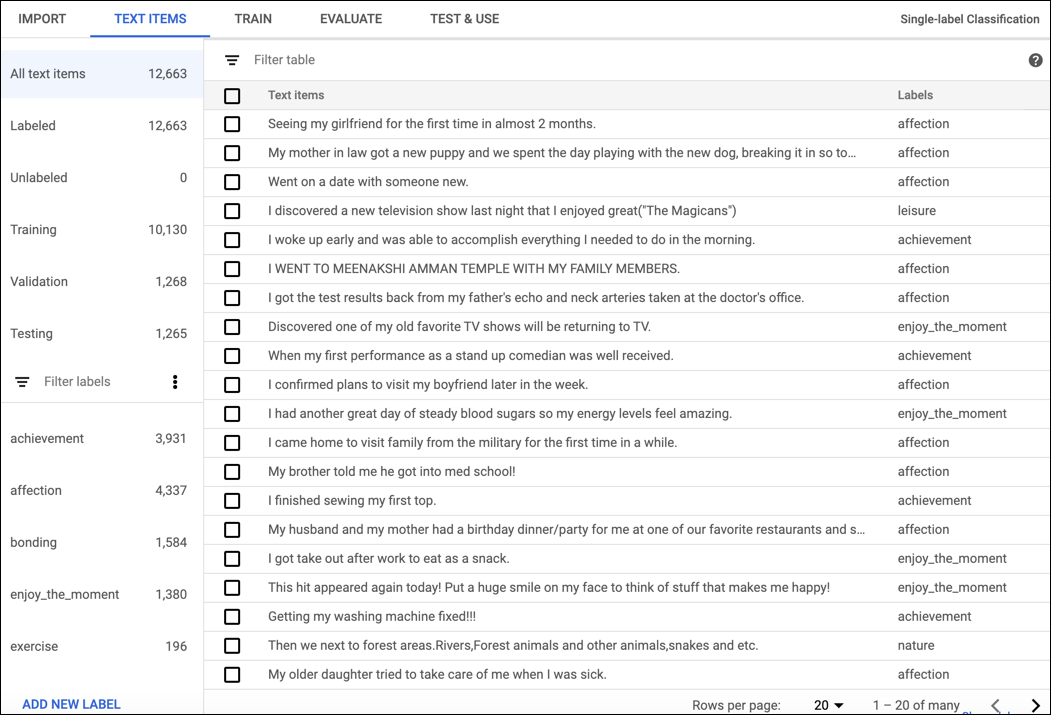如果您有一个包含一组带标签的固定训练文档的数据集,您就可以创建和训练自定义模型了。
训练模型可能需要几个小时才能完成。所需的训练时间取决于多种因素,例如数据集的大小、训练项的性质以及模型的复杂程度。AutoML Natural Language 使用早停法确保获得最佳的模型,避免出现过拟合问题。
对于分类模型,平均训练时间约为 6 小时,最长为 24 小时。对于实体提取和情感分析模式,平均训练时间为 5 小时,最长为 6 小时。
成功训练模型后,我们会向您的项目关联的电子邮件地址发送一封邮件。
自定义模型的最长使用期限为 18 个月。该时间期限过后,您必须创建并训练新模型,才能继续进行预测。
网页界面
如需训练模型,请执行以下操作:
打开 AutoML Natural Language 界面,然后在与您计划训练的模型类型对应的框中选择开始使用。
此时会出现数据集页面,其中显示了之前为当前项目创建的数据集的状态。如需使用其他项目的数据集进行训练,请从标题栏右上角的下拉列表中选择项目。
选择要用于训练自定义模型的数据集。
所选数据集的显示名会显示在标题栏中,该页面还会列出数据集中的各个文档及其标签。

查看完数据集后,点击标题栏正下方的训练标签页。
如果您要通过此数据集训练第一个模型,训练页面会提供对数据集的基本分析,并就其是否适合训练为您提供相关建议。如果 AutoML Natural Language 建议更改,请考虑返回文本项页面并添加文档或标签。
如果您已通过此数据集训练其他模型,训练页面会显示这些模型的基本评估指标。
点击开始训练。
输入模型的名称。
模型名称的长度不得超过 32 个字符,且只能包含字母、数字和下划线。第一个字符必须是字母。
(可选):如需训练医疗保健术语的实体提取模型,请选择启用 Healthcare Entity Extraction (Enable Healthcare Entity Extraction)(Beta 版)。通过此选项,您可以开始使用针对处理医疗保健数据进行了优化的医疗保健模型。如需了解详情,请参阅 AutoML Entity Extraction for Healthcare。
如果您想自动部署模型,请选中训练完成后部署模型复选框。
点击开始训练。
代码示例
分类
REST
在使用任何请求数据之前,请先进行以下替换:
- project-id:您的项目 ID
- location-id:资源的位置,全球位置为
us-central1,欧盟位置为eu - dataset-id:您的数据集 ID
HTTP 方法和网址:
POST https://automl.googleapis.com/v1/projects/project-id/locations/location-id/models
请求 JSON 正文:
{
"displayName": "test_model",
"dataset_id": "dataset-id",
"textClassificationModelMetadata": {
}
}
如需发送您的请求,请展开以下选项之一:
您应该会看到类似如下所示的输出。可以使用操作 ID 来获取任务的状态。如需示例,请参阅获取操作状态。
{
"name": "projects/434039606874/locations/us-central1/operations/1979469554520652445",
"metadata": {
"@type": "type.googleapis.com/google.cloud.automl.v1beta1.OperationMetadata",
"createTime": "2018-04-27T01:28:41.338120Z",
"updateTime": "2018-04-27T01:28:41.338120Z",
"cancellable": true
}
}
Python
如需了解如何安装和使用 AutoML Natural Language 的客户端库,请参阅 AutoML Natural Language 客户端库。 如需了解详情,请参阅 AutoML Natural Language Python API 参考文档。
如需向 AutoML Natural Language 进行身份验证,请设置应用默认凭据。如需了解详情,请参阅为本地开发环境设置身份验证。
Java
如需了解如何安装和使用 AutoML Natural Language 的客户端库,请参阅 AutoML Natural Language 客户端库。 如需了解详情,请参阅 AutoML Natural Language Java API 参考文档。
如需向 AutoML Natural Language 进行身份验证,请设置应用默认凭据。如需了解详情,请参阅为本地开发环境设置身份验证。
Node.js
如需了解如何安装和使用 AutoML Natural Language 的客户端库,请参阅 AutoML Natural Language 客户端库。 如需了解详情,请参阅 AutoML Natural Language Node.js API 参考文档。
如需向 AutoML Natural Language 进行身份验证,请设置应用默认凭据。如需了解详情,请参阅为本地开发环境设置身份验证。
Go
如需了解如何安装和使用 AutoML Natural Language 的客户端库,请参阅 AutoML Natural Language 客户端库。 如需了解详情,请参阅 AutoML Natural Language Go API 参考文档。
如需向 AutoML Natural Language 进行身份验证,请设置应用默认凭据。如需了解详情,请参阅为本地开发环境设置身份验证。
其他语言
C#: 请按照客户端库页面上的 C# 设置说明操作,然后访问 .NET 版 AutoML Natural Language 参考文档。
PHP: 请按照客户端库页面上的 PHP 设置说明操作,然后访问 PHP 版 AutoML Natural Language 参考文档。
Ruby: 请按照客户端库页面上的 Ruby 设置说明操作,然后访问 Ruby 版 AutoML Natural Language 参考文档。
实体提取
REST
在使用任何请求数据之前,请先进行以下替换:
- project-id:您的项目 ID
- location-id:资源的位置,全球位置为
us-central1,欧盟位置为eu - dataset-id:您的数据集 ID
- model-hint:要使用的基准模型,例如
default或healthcare(Beta 版)。
HTTP 方法和网址:
POST https://automl.googleapis.com/v1/projects/project-id/locations/location-id/models
请求 JSON 正文:
{
"displayName": "test_model",
"dataset_id": "dataset-id",
"textExtractionModelMetadata": {
"model_hint": "model-hint"
}
}
如需发送您的请求,请展开以下选项之一:
您应该会看到类似如下所示的输出。可以使用操作 ID 来获取任务的状态。如需示例,请参阅获取操作状态。
{
"name": "projects/434039606874/locations/us-central1/operations/1979469554520652445",
"metadata": {
"@type": "type.googleapis.com/google.cloud.automl.v1beta1.OperationMetadata",
"createTime": "2018-04-27T01:28:41.338120Z",
"updateTime": "2018-04-27T01:28:41.338120Z",
"cancellable": true
}
}
Python
如需了解如何安装和使用 AutoML Natural Language 的客户端库,请参阅 AutoML Natural Language 客户端库。 如需了解详情,请参阅 AutoML Natural Language Python API 参考文档。
如需向 AutoML Natural Language 进行身份验证,请设置应用默认凭据。如需了解详情,请参阅为本地开发环境设置身份验证。
Java
如需了解如何安装和使用 AutoML Natural Language 的客户端库,请参阅 AutoML Natural Language 客户端库。 如需了解详情,请参阅 AutoML Natural Language Java API 参考文档。
如需向 AutoML Natural Language 进行身份验证,请设置应用默认凭据。如需了解详情,请参阅为本地开发环境设置身份验证。
Node.js
如需了解如何安装和使用 AutoML Natural Language 的客户端库,请参阅 AutoML Natural Language 客户端库。 如需了解详情,请参阅 AutoML Natural Language Node.js API 参考文档。
如需向 AutoML Natural Language 进行身份验证,请设置应用默认凭据。如需了解详情,请参阅为本地开发环境设置身份验证。
Go
如需了解如何安装和使用 AutoML Natural Language 的客户端库,请参阅 AutoML Natural Language 客户端库。 如需了解详情,请参阅 AutoML Natural Language Go API 参考文档。
如需向 AutoML Natural Language 进行身份验证,请设置应用默认凭据。如需了解详情,请参阅为本地开发环境设置身份验证。
其他语言
C#: 请按照客户端库页面上的 C# 设置说明操作,然后访问 .NET 版 AutoML Natural Language 参考文档。
PHP: 请按照客户端库页面上的 PHP 设置说明操作,然后访问 PHP 版 AutoML Natural Language 参考文档。
Ruby: 请按照客户端库页面上的 Ruby 设置说明操作,然后访问 Ruby 版 AutoML Natural Language 参考文档。
情感分析
REST
在使用任何请求数据之前,请先进行以下替换:
- project-id:您的项目 ID
- location-id:资源的位置,全球位置为
us-central1,欧盟位置为eu - dataset-id:您的数据集 ID
HTTP 方法和网址:
POST https://automl.googleapis.com/v1/projects/project-id/locations/location-id/models
请求 JSON 正文:
{
"displayName": "test_model",
"dataset_id": "dataset-id",
"textSentimentModelMetadata": {
}
}
如需发送您的请求,请展开以下选项之一:
您应该会看到类似如下所示的输出。可以使用操作 ID 来获取任务的状态。如需示例,请参阅获取操作状态。
{
"name": "projects/434039606874/locations/us-central1/operations/1979469554520652445",
"metadata": {
"@type": "type.googleapis.com/google.cloud.automl.v1beta1.OperationMetadata",
"createTime": "2018-04-27T01:28:41.338120Z",
"updateTime": "2018-04-27T01:28:41.338120Z",
"cancellable": true
}
}
Python
如需了解如何安装和使用 AutoML Natural Language 的客户端库,请参阅 AutoML Natural Language 客户端库。 如需了解详情,请参阅 AutoML Natural Language Python API 参考文档。
如需向 AutoML Natural Language 进行身份验证,请设置应用默认凭据。如需了解详情,请参阅为本地开发环境设置身份验证。
Java
如需了解如何安装和使用 AutoML Natural Language 的客户端库,请参阅 AutoML Natural Language 客户端库。 如需了解详情,请参阅 AutoML Natural Language Java API 参考文档。
如需向 AutoML Natural Language 进行身份验证,请设置应用默认凭据。如需了解详情,请参阅为本地开发环境设置身份验证。
Node.js
如需了解如何安装和使用 AutoML Natural Language 的客户端库,请参阅 AutoML Natural Language 客户端库。 如需了解详情,请参阅 AutoML Natural Language Node.js API 参考文档。
如需向 AutoML Natural Language 进行身份验证,请设置应用默认凭据。如需了解详情,请参阅为本地开发环境设置身份验证。
Go
如需了解如何安装和使用 AutoML Natural Language 的客户端库,请参阅 AutoML Natural Language 客户端库。 如需了解详情,请参阅 AutoML Natural Language Go API 参考文档。
如需向 AutoML Natural Language 进行身份验证,请设置应用默认凭据。如需了解详情,请参阅为本地开发环境设置身份验证。
其他语言
C#: 请按照客户端库页面上的 C# 设置说明操作,然后访问 .NET 版 AutoML Natural Language 参考文档。
PHP: 请按照客户端库页面上的 PHP 设置说明操作,然后访问 PHP 版 AutoML Natural Language 参考文档。
Ruby: 请按照客户端库页面上的 Ruby 设置说明操作,然后访问 Ruby 版 AutoML Natural Language 参考文档。

